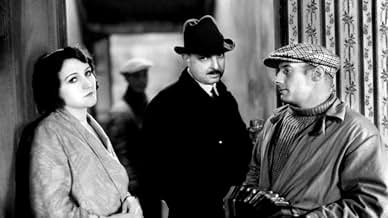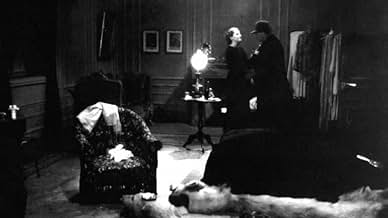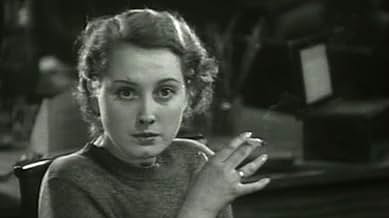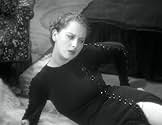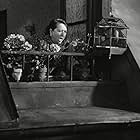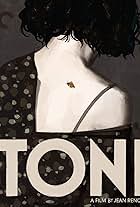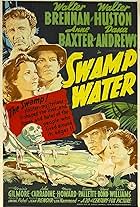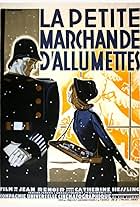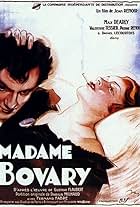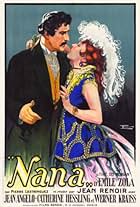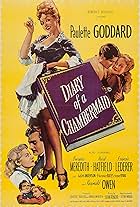IMDb RATING
6.5/10
983
YOUR RATING
Inspector Maigret investigates the mysterious murder of a Dutch diamond dealer, found dead in a stolen car. The car belongs to an insurance agent, Michonnet, and has been abandoned in the ga... Read allInspector Maigret investigates the mysterious murder of a Dutch diamond dealer, found dead in a stolen car. The car belongs to an insurance agent, Michonnet, and has been abandoned in the garage belonging to Carl Andersen.Inspector Maigret investigates the mysterious murder of a Dutch diamond dealer, found dead in a stolen car. The car belongs to an insurance agent, Michonnet, and has been abandoned in the garage belonging to Carl Andersen.
Georges Térof
- Lucas
- (as G. Terof)
Winna Winifried
- Else Andersen
- (as Winna Winfried)
Georges Koudria
- Carl Andersen
- (as George Koudria)
G.A. Martin
- Granjean
- (as Martin)
Jean Gehret
- Emile Michonnet
- (as Gehret)
Max Dalban
- Le docteur
- (as Dalban)
Roger Gaillard
- Le boucher
- (as Gaillard)
Manuel Raaby
- Guido
- (as Rabby)
- Director
- Writers
- All cast & crew
- Production, box office & more at IMDbPro
Storyline
Did you know
- TriviaGeorges Simenon was living on a houseboat when his novel was published in 1931. Very shortly afterward, he was sitting on the deck of his boat, typing a new novel, when a large car drew up on the quay to which it was moored, and a stranger got out. It was Jean Renoir, a filmmaker Simenon admired but did not know; Renoir went straight up to him and made an offer for the film rights on the spot. Simenon accepted immediately and the deal went through with no further complications-- quite possibly the quickest and most straightforward sale of film rights to a novel in movie history. The two men were lifelong friends thereafter and Simenon was devastated by Renoir's death, some 47 years later.
- ConnectionsEdited into Histoire(s) du cinéma: Une histoire seule (1989)
Featured review
"Night at the Crossroads" has the reputation of Jean Renoir's least-known sound film. Whether this is justified or not, it is not hard to understand why it has fallen by the wayside. Not as openly political as his later films as well as lacking in a coherent plot, it is easy to dismiss this film based on an early Georges Simenon novel as just another pulp detective yarn made as an imitation of the increasingly popular Hollywood gangster films. Indeed, Renoir's own dissatisfaction with the film and the rumours that it was never completed haven't helped its reputation. However, in "Night at the Crossroads", Renoir has made a film so beguilingly atmospheric and infuriatingly irrational, that it simply mustn't be dismissed.
The plot, such as it is, follows the investigation into the murder of a Jewish diamond merchant found in the garage of a house near a small French village. The house itself is located on a crossroad and belongs to a mysterious one-eyed Dane (Georges Koudria) and his flirtatious sister (Winna Winifried). Opposite the house, on the crossroad, is a garage and next to it, the house of the portly Mr Michnnet (Jean Gehret).
Enter Inspector Maigret (Pierre Renoir), Surete's indefatigable investigator taking charge of the case. He takes a temporary residence at the crossroad which he finds to be a less than idyllic place.
Proceeding in odd fits and jumps and seemingly lacking any continuity between its many twists and reveals, the plot is hardly of consequence in this thriller. Rumour has it that certain key scenes either weren't filmed or were lost at some point during the production. I don't believe this to be the case. It seems to me more likely that Jean Renoir was simply more interested in the bizarre cast of characters cohabitating at this dreary French crossroads and the gothic atmosphere of the Simenon novel than its frequently ludicrous plot machinations.
I didn't find the plot that hard to follow, it is simply unfolded in such an off-hand manner that it seems more incidental than is usual in a crime movie. Most key events take place off-screen. Characters are kidnapped and released, lost and found out of sight of the camera or Maigret who seems to spend most of his time wandering between the three houses as bemused by all the oddness found in them as we are. Most of the twists are explained after they occur in the form of throwaway dialogue and all of the deductions from Maigret seem to come out of nowhere. In fact, in some cases, they seem to be more divinations than deductions since he doesn't seem to have any clues whatsoever.
As I said, it is the thick, gloomy, often bizarre atmosphere that is what drives this film and many of the elements at play in "Night at the Crossroads" wouldn't seem out of place in a David Lynch film. Just look at the cast of characters. Besides the straight-laced Maigret, we have his minute, goofy assistant, a constantly grinning, bear-like local inspector, an accordion-playing garage owner, a melancholic, black monocle-wearing Dane, his apparently nymphomaniac sister, and a greatly disliked accountant who always seems to be running somewhere. Furthermore, just like Lynch, Renoir cuts between disparate styles with reckless abandon. Every scene in this film seems to be shot in a different genre ranging freely from gothic horror to slapstick comedy, from torrid romantic melodrama to American gangster flicks. In between all of this, Renoir frequently cuts in complete non-sequitur shots such as the sexy Danish nymph seductively playing with a pet tortoise.
Surprisingly, Renoir mostly manages to hold it all together with the film's sorrowful, bleak atmosphere acting as a kind of cohesive. The film's memorable location, the country crossroad seemingly between nothing and nowhere, drenched in rain and fog, simply oozes it.
The photography by Georges Asselin and Marcel Lucien is simply astounding and although the film occasionally suffers from the ails of early talkies such as odd framing choices and static, talky scenes, the images on display are simply beautiful. Mostly shot at night or in darkness, there are very few light sources evident in the scenes and quite a few of them are diegetic. There are wonderful shots of figures walking through the misty night illuminated only by passing headlights or entire scenes in which the only light source appears to be a desk lamp engulfed in cigarette smoke. Add into the mix the constantly drizzling rain and you get a film set in a murky world in which morality is grey and the line between good and bad is utterly obscured. The climactic chase scene is shot from the POV of the chasing car, in the night, with only that car's headlights lighting the way. The effect is one of total immersion.
This wouldn't be a Renoir film if it didn't offer up the occasional social commentary and here he uses Simenon's set-up quite brilliantly to his ends. By setting each of the tenants of the crossroads on a different rung of the social ladder, he has them in constant conflict, a kind of brewing cold war. The garage workers are, of course, working-class men whom we are first introduced to mockingly reading the society pages of the newspaper. There is an open disliking between them and Monsieur Michonnet, the recently wealthy accountant whom they refer to as "the bourgeoise". However, when the murder takes place, they join forces in pointing the accusatory finger at the Danes, finally united in their xenophobia. The Danes, on the other hand, show little empathy for the Jewish victim seeing how they're antisemitic. Renoir has a lot of fun portraying this cold war along with several other barbed jabs such as the scene of Parisiennes buying the newspapers being framed to show filthy water flowing into the street gutters. A literal depiction of the term "gutter press".
"Night at the Crossroads" is a far more interesting and innovative film than it may seem on the surface. It is certainly no pulp crime story and can hardly be called a detective film at all since the plot plays only a cursory role. Not all of it works. It is sometimes incoherent and distracting, and its oddity is frequently overwhelming, however, once you accept its flaws and allow yourself to enjoy its bizarrity unencumbered with attempts at understanding it, you'll find yourself engulfed in its curiously powerful, drizzly, sorrowful, gothic atmosphere.
The plot, such as it is, follows the investigation into the murder of a Jewish diamond merchant found in the garage of a house near a small French village. The house itself is located on a crossroad and belongs to a mysterious one-eyed Dane (Georges Koudria) and his flirtatious sister (Winna Winifried). Opposite the house, on the crossroad, is a garage and next to it, the house of the portly Mr Michnnet (Jean Gehret).
Enter Inspector Maigret (Pierre Renoir), Surete's indefatigable investigator taking charge of the case. He takes a temporary residence at the crossroad which he finds to be a less than idyllic place.
Proceeding in odd fits and jumps and seemingly lacking any continuity between its many twists and reveals, the plot is hardly of consequence in this thriller. Rumour has it that certain key scenes either weren't filmed or were lost at some point during the production. I don't believe this to be the case. It seems to me more likely that Jean Renoir was simply more interested in the bizarre cast of characters cohabitating at this dreary French crossroads and the gothic atmosphere of the Simenon novel than its frequently ludicrous plot machinations.
I didn't find the plot that hard to follow, it is simply unfolded in such an off-hand manner that it seems more incidental than is usual in a crime movie. Most key events take place off-screen. Characters are kidnapped and released, lost and found out of sight of the camera or Maigret who seems to spend most of his time wandering between the three houses as bemused by all the oddness found in them as we are. Most of the twists are explained after they occur in the form of throwaway dialogue and all of the deductions from Maigret seem to come out of nowhere. In fact, in some cases, they seem to be more divinations than deductions since he doesn't seem to have any clues whatsoever.
As I said, it is the thick, gloomy, often bizarre atmosphere that is what drives this film and many of the elements at play in "Night at the Crossroads" wouldn't seem out of place in a David Lynch film. Just look at the cast of characters. Besides the straight-laced Maigret, we have his minute, goofy assistant, a constantly grinning, bear-like local inspector, an accordion-playing garage owner, a melancholic, black monocle-wearing Dane, his apparently nymphomaniac sister, and a greatly disliked accountant who always seems to be running somewhere. Furthermore, just like Lynch, Renoir cuts between disparate styles with reckless abandon. Every scene in this film seems to be shot in a different genre ranging freely from gothic horror to slapstick comedy, from torrid romantic melodrama to American gangster flicks. In between all of this, Renoir frequently cuts in complete non-sequitur shots such as the sexy Danish nymph seductively playing with a pet tortoise.
Surprisingly, Renoir mostly manages to hold it all together with the film's sorrowful, bleak atmosphere acting as a kind of cohesive. The film's memorable location, the country crossroad seemingly between nothing and nowhere, drenched in rain and fog, simply oozes it.
The photography by Georges Asselin and Marcel Lucien is simply astounding and although the film occasionally suffers from the ails of early talkies such as odd framing choices and static, talky scenes, the images on display are simply beautiful. Mostly shot at night or in darkness, there are very few light sources evident in the scenes and quite a few of them are diegetic. There are wonderful shots of figures walking through the misty night illuminated only by passing headlights or entire scenes in which the only light source appears to be a desk lamp engulfed in cigarette smoke. Add into the mix the constantly drizzling rain and you get a film set in a murky world in which morality is grey and the line between good and bad is utterly obscured. The climactic chase scene is shot from the POV of the chasing car, in the night, with only that car's headlights lighting the way. The effect is one of total immersion.
This wouldn't be a Renoir film if it didn't offer up the occasional social commentary and here he uses Simenon's set-up quite brilliantly to his ends. By setting each of the tenants of the crossroads on a different rung of the social ladder, he has them in constant conflict, a kind of brewing cold war. The garage workers are, of course, working-class men whom we are first introduced to mockingly reading the society pages of the newspaper. There is an open disliking between them and Monsieur Michonnet, the recently wealthy accountant whom they refer to as "the bourgeoise". However, when the murder takes place, they join forces in pointing the accusatory finger at the Danes, finally united in their xenophobia. The Danes, on the other hand, show little empathy for the Jewish victim seeing how they're antisemitic. Renoir has a lot of fun portraying this cold war along with several other barbed jabs such as the scene of Parisiennes buying the newspapers being framed to show filthy water flowing into the street gutters. A literal depiction of the term "gutter press".
"Night at the Crossroads" is a far more interesting and innovative film than it may seem on the surface. It is certainly no pulp crime story and can hardly be called a detective film at all since the plot plays only a cursory role. Not all of it works. It is sometimes incoherent and distracting, and its oddity is frequently overwhelming, however, once you accept its flaws and allow yourself to enjoy its bizarrity unencumbered with attempts at understanding it, you'll find yourself engulfed in its curiously powerful, drizzly, sorrowful, gothic atmosphere.
Details
- Release date
- Country of origin
- Languages
- Also known as
- Noc na raskrscu
- Filming locations
- Carrefour de la Croix Verte, Bouffémont, Val-d'Oise, France(The Andersens' house and garage)
- Production company
- See more company credits at IMDbPro
- Runtime1 hour 15 minutes
- Color
- Aspect ratio
- 1.20 : 1
Contribute to this page
Suggest an edit or add missing content

Top Gap
By what name was Night at the Crossroads (1932) officially released in India in English?
Answer


